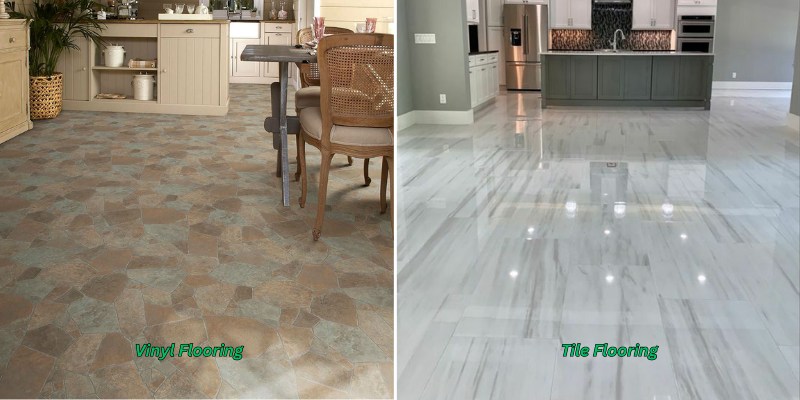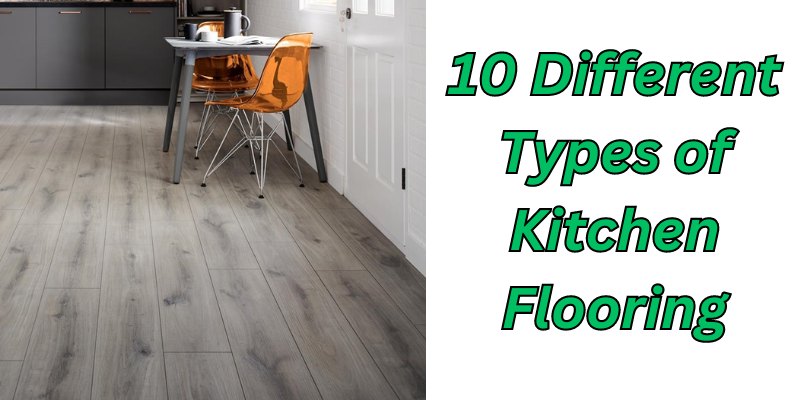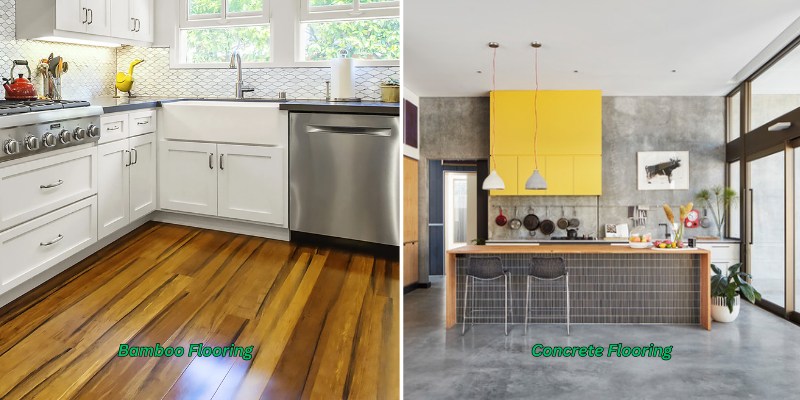Your kitchen floor endures an obscene amount of trampling and spilling on an everyday basis. Therefore, you can start by installing one of these 10 different types of kitchen flooring so as not to ruin its aesthetic as well as functionality.
Your kitchen is the heart of your house which makes your home feel welcoming. Choosing the perfect flooring is necessary for withstanding high temperatures and even impromptu food splatters. Plus, it can very easily accumulate dirt from the constant workout it receives.
So, avoid slippery floors to prevent injury in case you have toddlers. Make sure your kitchen floors are also durable against corrosion. Moreover, they should be easy to clean.
Sounds overwhelming? Stay tuned as we’ll present you with 10 different types of kitchen flooring to guide you through your journey.
Hardwood Flooring
Hardwood floorings can add value to your kitchen if engineered properly.These floors can last you longer as they are pretty durable. Cooking is usually comfortable as they’re softer than other options. Bonus, they add a more sophisticated touch to your kitchen.
But they require high maintenance. These floors get scuffed and are vulnerable to water. Discoloration also occurs with direct exposure to sunlight. Moreover, they can get quite costly.
Therefore, white oak or maple should be installed as they’re sustainable to damage. Pinewood floors with a natural matte finish are usually the most suitable.Make sure to instantly mop away any spills and use protective rugs.

Laminate Flooring
Laminate floorings can mimic any hardwood or tile look at a lower cost.You can easily install these floors as a DIY project. They’re great for the kitchen as dust isn’t quickly accumulated and they’re resistant to stains. These floors are also cheaper than others.
However, a major drawback is that they look artificial with repeated patterns. Walking can make noise if not installed properly. Also, they need replacements once damaged from moisture accumulation.
Install your laminate floorings with wax edges to avoid spill damage. Glossy or matte finishes are among the popular options.Use foam barriers to minimize noise and floor protectors under furniture.
Vinyl Flooring
Vinyl floorings are versatile in terms of patterns and textures.They not only look attractive but are also totally waterproof. So any kind of spilling can be easily wiped away. Also, termite infestation is totally out of an option.
These floors will more likely get dented from sharp knives tumbling over. Your original floor can get damaged as they’re glued down. The adhesive used can also lead to the emission of volatile organic compounds causing health risks.
If installed correctly, vinyl floors won’t budge. Plus, they’re best for kitchens as they work well in wet areas.Scrubbing with steel wool and dragging heavy appliances are strictly prohibited.

Tile Flooring
Tile floorings can easily transform your kitchen into a high-end.They are ideal for long-term flooring without any scratches surfacing. Moreover, buying cleaning supplies should be cut in half as they’re both water and stain resistant.
But grout lines usually get quite dirty. If you love to cook barefoot, tiles aren’t a good option. This is because they get pretty cold during winter and are also not comfortable walking around.
Ceramic or porcelain tiles are usually inserted in kitchens to add depth to your home.Remember to be safe with glass crockeries as they break due to falling and scrub the grouts regularly.
Stone Flooring
Stone floorings are among the popular choices if you’re into Mediterranean-style kitchens.These floors not only elevate the vibe of your kitchen but would also last you for a long time. They’re also not slippery and remain cool during summer.
Since they’re pretty rigid, falling face down can severely injure you. Natural stone is definitely porous which is why the floors can chip easily. not to mention, they can get very pricey.
Marble and limestone floors can single-handedly add a more professional touch to your kitchen. Add waterproofing products to save your floor from spills and avoid ammonia-based cleaning cleaning supplies.

Cork Flooring
Cork floorings are eco-friendly and easily the greenest alternatives for flooring.Glass utensils don’t break if fallen into cork floors. Additionally, you won’t also get hurt from tripping over accidentally. Molding is prevented on these floors. Standing during cooking is also comfortable as they’re soft.
Animal scratches look very prominent on cork floorings. They often get wrinkly due to humidity. Annual sealings are also required to prevent swelling from absorbing water.
Using these floors are great options for keeping yourself cozy while cooking. They’re also safe for kids.Avoid steam cleaners and keep your cork floorings dry. Otherwise, they’ll get ruined.
Bamboo Flooring
Bamboo floorings are similar to hardwood except they’re much more environment-friendly.These floors are better at withstanding water spills and can be cleaned easily with periodic moppings. They are much cheaper and pests aren’t really attracted to bamboos. Any visible denting can be quickly repaired.
But they often get damped due to humid weather. This makes them shortlived than hardwood floorings. These floors can also trigger allergies as the adhesive used can sometimes give off toxic gases.
Stained or caramelized bamboo floorings are currently on trend. They’re also much easier to harness for different styles.Remember to not let your kitchen get humid and avoid wet mopping every day.
Concrete Flooring
Concrete floorings particularly fit into a certain genre of aesthetic.When stained accurately, these floors can mimic stone floorings. They’re extremely durable and long-lasting. Plus, they can absorb heat during the daytime and remain cold during nighttime.
However, radiant floor heating is necessary for nighttime use. Installing them requires appropriate skills. Because of their rigidity, cooking for hours can be quite tiring.
Acid staining is quite popular for achieving an original stone-like finish. They’re also polished for getting the perfect shine.Don’t scratch aggressively but rather vacuum on a daily basis to retain its polish.
Linoleum Flooring
Linoleum floorings are one of the cheapest flooring options.They’re made from linseed oil. It means they’re biodegradable when discarded which in turn makes them eco-friendly. These floors are also bouncy and comfortable to walk on. Your toes are bound to remain heated.
Sealings are required on an annual basis. Otherwise, they’ll age by turning yellow. Light also plays a factor in corrosion and linseed fumes can give off a very strong odor for days.
Colorful linoleum floorings present your kitchen with a retro touch. It’s better to add coatings to prevent staining.Regularly clean the floor by changing the cleaning solutions periodically.

Carpet Flooring
Carpet floorings add more of a Victorian touch to your kitchen.You can add your personality by mixing and matching patterns. They’re very comfortable for sore feet and quieter to walk on. Moreover, you can just thoroughly wash them with bleach if they get dirty.
It’s true that they get greasy which means you need to replace them bi-annually. Regular walking will cause wear and tear more quickly than other options. So they require high maintenance.
Therefore, carpet floorings can easily brighten up your kitchen. They’re mainly installed for toddlers and act as noise-cancellation floorings.Vacuum on a daily basis and brush areas dented by furniture.
Summary: Choosing the Perfect Kitchen Flooring
Kitchen floors speak volumes about your personality. So choosing among these 10 different types of kitchen flooring will make your neighbors speak highly of your taste.
In short, choosing the right kitchen floors will make your cooking enjoyable. Hardwood floorings are durable but damaged by moisture. Laminate floorings are easily installed but cannot be refinished. Termite infestation can’t occur in vinyl floorings but they aren’t scratch-proof.
Tile floorings are water-resistant but get cold. Stone floorings are long-lasting but can injure you. Cork floorings swell up but are cozy. Bamboo floorings are greener but get damped. Concrete floorings are eco-friendly but are very hard. Linoleum floorings are biodegradable but can discolor. Carpet floorings add color to your kitchen but are high-maintenance.
Therefore, you should first choose your kitchen floorings according to your taste within your budget. Next, make sure they’re long-lasting and durable. Finally, they should be easy to tidy.
So, by using our guidelines make sure to choose your perfect kitchen flooring!
FAQs
How do I determine the best kitchen flooring for my needs?
Mostly it depends on your taste and functionality. Hardwood floorings provide your kitchen with a timeless look. Tile floorings are both stain-resistant and waterproof. Concrete floorings last you for more than decades. And, carpet floorings complement your kitchen with a burst of colors.
What is the most durable kitchen flooring option?
Concrete floorings are among the most durable flooring options. They’re extremely impact-resistant – they’re scratch-proof and don’t wear and tear easily. A close competitor is ceramic tile floorings. They’re both impact-resistant and heatproof.
Can I install the kitchen flooring myself, or should I hire a professional?
If you don’t have the proper expertise or the right materials, installing your kitchen flooring by yourself can turn into a nightmare. In that case, you should hire professionals who have a proper experience and ideas about the appropriate sizing requirements. However, if you’re skilled enough, try installing it on your own!


Choosing the right kitchen flooring is a crucial decision that marries aesthetics and practicality. This comprehensive guide presents 10 distinct flooring types to help you make an informed choice.
Hardwood flooring exudes sophistication and durability, but maintenance can be high. Laminate floors offer cost-effective mimicry of hardwood or tile, but quality installation is key. Vinyl flooring impresses with versatility and waterproof attributes, though careful installation is necessary to avoid emissions.
Tile flooring boasts elegance and resilience against stains and water. Stone flooring captures a Mediterranean vibe, yet vigilance is required against chips and falls. Eco-conscious consumers might gravitate toward cork flooring, appreciating its softness and warmth, despite the need for sealing.
Bamboo flooring combines environmental friendliness with ease of cleaning, but humidity sensitivity may impact longevity. Concrete floors exude an industrial charm, requiring expert installation for optimal results. Linoleum flooring’s affordability and biodegradability offset its susceptibility to discoloration.
Carpet flooring introduces Victorian aesthetics, prioritizing comfort over ease of maintenance. Each type offers a unique balance of pros and cons, catering to various preferences and needs. When choosing, consider longevity, aesthetics, comfort, and practicality to ensure your kitchen floor aligns with your lifestyle.
Visit For more Inforamation https://microdeft.com/best-interior-design-in-bangladesh/